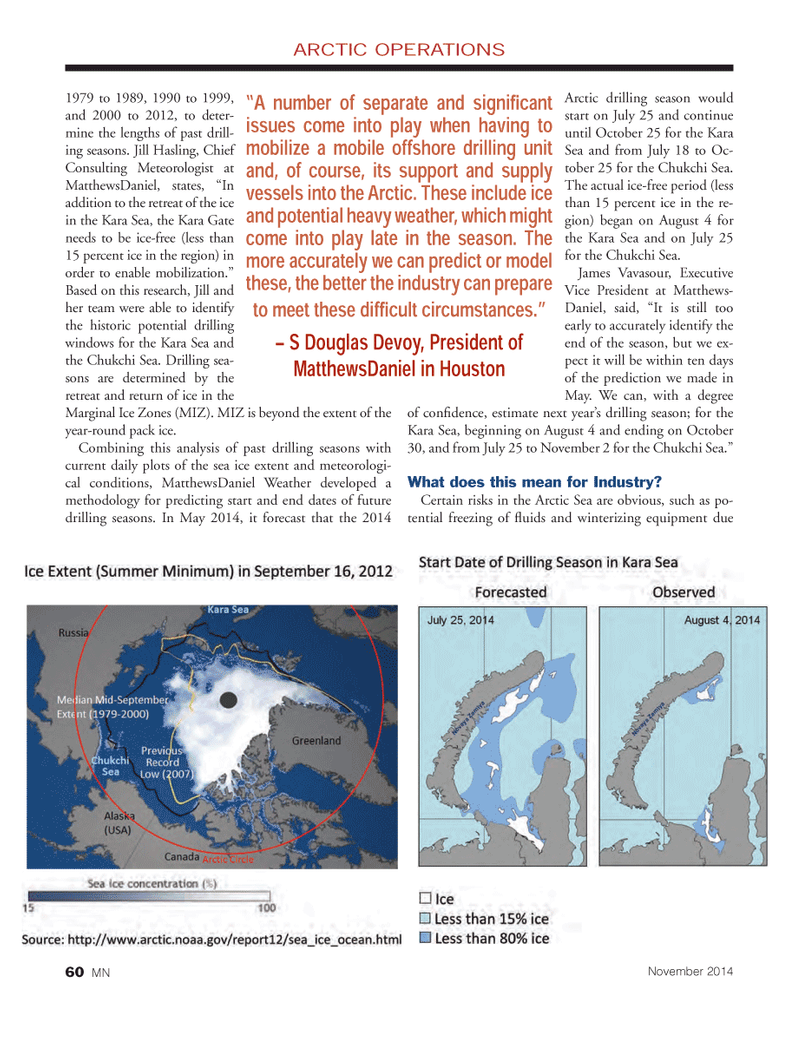
Page 60: of Marine News Magazine (November 2014)
Workboat Annual
Read this page in Pdf, Flash or Html5 edition of November 2014 Marine News Magazine
1979 to 1989, 1990 to 1999, and 2000 to 2012, to deter- mine the lengths of past drill- ing seasons. Jill Hasling, Chief
Consulting Meteorologist at
MatthewsDaniel, states, “In addition to the retreat of the ice in the Kara Sea, the Kara Gate needs to be ice-free (less than 15 percent ice in the region) in order to enable mobilization.”
Based on this research, Jill and her team were able to identify the historic potential drilling windows for the Kara Sea and the Chukchi Sea. Drilling sea- sons are determined by the retreat and return of ice in the
Marginal Ice Zones (MIZ). MIZ is beyond the extent of the year-round pack ice.
Combining this analysis of past drilling seasons with current daily plots of the sea ice extent and meteorologi- cal conditions, MatthewsDaniel Weather developed a methodology for predicting start and end dates of future drilling seasons. In May 2014, it forecast that the 2014
Arctic drilling season would start on July 25 and continue until October 25 for the Kara
Sea and from July 18 to Oc- tober 25 for the Chukchi Sea.
The actual ice-free period (less than 15 percent ice in the re- gion) began on August 4 for the Kara Sea and on July 25 for the Chukchi Sea.
James Vavasour, Executive
Vice President at Matthews-
Daniel, said, “It is still too early to accurately identify the end of the season, but we ex- pect it will be within ten days of the prediction we made in
May. We can, with a degree of confi dence, estimate next year’s drilling season; for the
Kara Sea, beginning on August 4 and ending on October 30, and from July 25 to November 2 for the Chukchi Sea.”
What does this mean for Industry?
Certain risks in the Arctic Sea are obvious, such as po- tential freezing of fl uids and winterizing equipment due
ARCTIC OPERATIONS “A number of separate and signifi cant issues come into play when having to mobilize a mobile offshore drilling unit and, of course, its support and supply vessels into the Arctic. These include ice and potential heavy weather, which might come into play late in the season. The more accurately we can predict or model these, the better the industry can prepare to meet these diffi cult circumstances.” – S Douglas Devoy, President of
MatthewsDaniel in Houston
November 2014 60 MN
MN Nov14 Layout 50-65.indd 60 10/23/2014 10:40:27 AM

 59
59

 61
61
